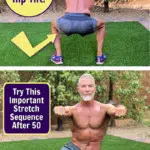Improve how your body looks and feels. When one hip becomes too tight, it creates a pelvic tilt, risking the knees and lower back. Try this important hip stretch sequence after 50.
Why Having Healthy Hips Matters More As You Age
A fundamental signal of good health in people over 50 is the ability to bend their knees and do a basic squat.
But squatting can be unsafe when one hip gets asymmetrically tight – because it creates a lateral pelvic tilt that compromises the knees and lower back.
This article reveals an essential hip stretch sequence for people after 50. This stretch sequence helps create an even suppleness to the hips so that squatting becomes almost effortless.
The video lower within this article shows how the stretch sequence appears in action.The 90-90 Hip Stretch Sequence Is Crucial
After 50, most people don’t realize that one of their hips is significantly tighter than the other.
There’s an easy way to tell if this is the case with you.
Use your phone to film a vertical video of yourself doing a few repetitions of a basic air squat.
The video should capture you from behind.

If you look closely, you’ll notice that one of your hips tilts to the left or right at the bottom of your squat.
“Your hips are the center of movement for your body. If you have stiff hips, you’re going to move poorly.”
–Kelly Starrett, physiotherapist and author
Over the years, I’ve noticed working with clients that most people tilt to the left. But whatever side you tilt on, that is your “tight” side – and you’ll want to spend extra time on that side during the hip stretch sequence.
You can also film a candid video (from the front) of you walking (as you usually walk). If your feet turn out (even a little) into a duck-waddle position, this also can be a sign of overly tight hips.
Unfortunately, doing this stretch only once or twice a month won’t be enough to change your physiology. Do this hip stretch at least three times a week to help permanently improve your alignment and raise your baseline of flexibility.
Try This Hip Stretch Sequence After 50
Sit on the floor with both legs bent at 90-degree angles – one leg in front of you and the other behind you, with your arms in the air in front of your torso.
Now, switch sides so the other leg is in front, and the other leg is in back.
Immediately, you’ll probably notice that one hip is tighter than the other. You’ll notice this because the tight side makes it much more difficult to sit upright without using your hands on the floor to “cheat.”
Now that you know which side is tighter, you can use a bolster, block, half-roller, or towel underneath that tight hip.
Propping your hip up this way will make it easier to sit upright without your hands on the floor for support.
- First, hold the 90-90 position for 30 seconds with arms raised. Keep your navel pulled in, your glutes activated, and your spine tall.
- Next, do “can openers,” where you rotate your spine with bent arms for 20 repetitions.
- Then, do hip thrusts, in which you lift your hips off the floor and thrust them forward, then return the hips to the ground. 20 reps.
- Finally, relax forward into a fully released hip stretch. Explore all the nooks and crannies – forward to the left, forward to the right, and, finally, entirely over to the side, resting your head on the floor. Hold for a full minute while you take slow, deep breaths.
“Forget My Hips, My Knees Are Tender!”
For some of you, your knees will be so tender that holding the 90-90 position would be unbearable even if your hips were utterly flexible.
If you experience profound knee discomfort while attempting the 90-90 position, I encourage you to consider an anti-inflammatory diet. It can help considerably. Run this idea by your medical doctor during your next check-up.
